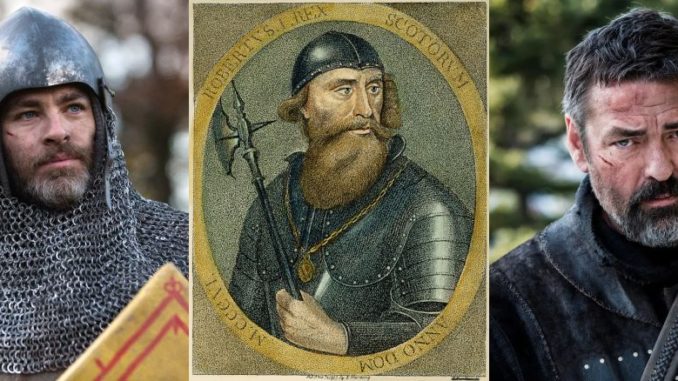
William Wallace may have got the Oscar-winning motion picture, but there’s a good case to be made that, in terms of impact in Scottish history, a much more influential figure was his contemporary, Robert the Bruce. For after the death of Wallace in 1305, Bruce took up the cause of independence from England, and became its standard bearer over the following years. However, in order to do so and become Scotland’s King, he had to navigate the claims of other contenders to the throne, not all of whom were as averse to English patronage as Robert. Chief among them was Robert Comyn, the most powerful noble in the country. Bruce took care of him during a meeting at Greyfriars Monastery, an act which won him formal excommunication, but the support of some Scottish bishops, who crowned him king anyway.
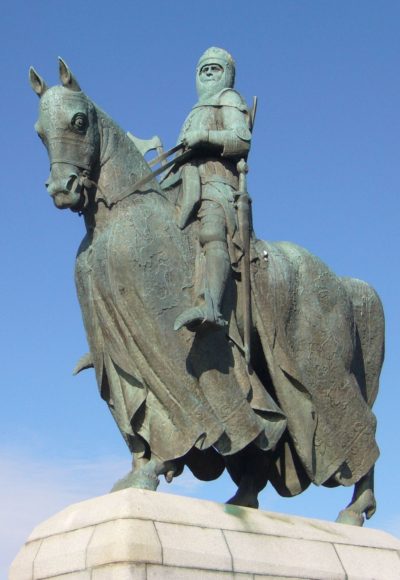
The first years of the subsequent rebellion did not go well, with Edward I and his son, the Prince of Wales, sallying forth, seizing Bruce’s lands and giving them to English loyalists. His brother and wife fell into Edward’s hands, and Bruce was sent into hiding, most likely in the Western Isles. He regrouped his forces, and returned to the fray in early 1307, beginning a guerilla campaign. This proved increasingly successful, and the English lost their king when Edward caught a fatal case of dysentery, while heading north to take on the rebels. His son took over, as Edward II, but Bruce ran wild in the highlands of Scotland, wiping out the Comyn’s power in the North-East. By the summer of 1309, King Robert controlled all of Scotland north of the River Tay.
His guerilla tactics continued to prove thoroughly effective, but in 1314, Edward II sent a force of 15,000-20,000 into Scotland to deal with Bruce. In an unexpected change of tactics, the Scottish army went head-on against the English at Bannockburn, and obtained a decisive victory, Edward only narrowly escaping with his life. While hardly the end of hostilities between the two countries, he basically secured Scottish independence, for almost the next four hundred years. Bruce himself occupied the throne until his death in 1329. His lineage continues down to the current Queen Elizabeth II, who is his 19 times great-granddaughter.
For such a key figure in Scottish history, he has been largely ignored in terms of popular culture. He was the topic of Rossini’s last opera in 1843, but it wasn’t until 1996 that the first movie focusing on Bruce was made, coming rapidly on the heels of Braveheart, when medieval Scottish independence movies were briefly hot. Of course, you wait 650 years and then several come along at once. Okay, not quite “at once”, but compared to the previous dearth, three in a quarter century is quite a torrid pace. Below, you’ll find reviews of each of them.

The Bruce (1996)
Rating: D+
Dir: Bob Carruthers, David McWhinnie
Star: Sandy Welch, Brian Blessed, Oliver Reed, Pavel Douglas
I’ll confess to being rather confused by the opening scene, which has Scottish knights in front of… the Pyramids? Turns out, it’s a flash forward to later times, and Bruce’s dying wish to have his heart taken to the Holy Land. Guess the knights in question overshot and landed in Egypt, not Israel. Close enough. It continues on shaky historical territory, fabricating entirely a battle between Scottish and English forces, which provides cause for Robert (Welch) to kill English supporter and rival for the throne, Comyn (Douglas). From there, however, it settles down to a reasonably accurate if compressed recounting – if you discount the inevitable Highland bagpipes showing up too early. However, you’re then forced to look at the rest of the production, and it’s not good. In most ways, it resembles something made for schools’ television: making up in earnestness, what it lacks in resources.
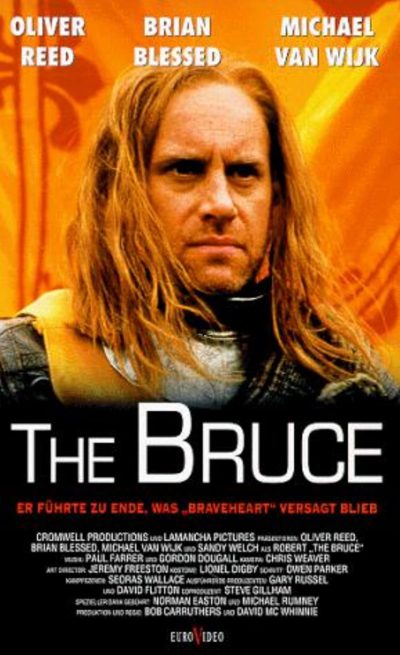 It may have been a mistake to bring on board Blessed, as King Edward I, and Reed, playing head of the Scottish church, Bishop Wisharton. Their performances are probably too good, since the gap between them and most of the rest of the cast is yawning chasm-sized. [Random note: Edward’s wife, Queen Eleanor, is played by Blessed’s actual wife Hildegard Neil. Perhaps there was a 2-for-1 deal?] Elsewhere though, I was amused to see Dee Hepburn, a.k.a. Gregory’s Girl, as Bruce’s sister, and Michael Van Wijk a.k.a. Wolf from Gladiators, playing English thug Henry De Bohun. When a film is depicting a figure like this, who rallied and united a nation, you need an actor with charisma, so the audience will want to follow him too. Welch doesn’t have it, and the movie founders in consequence.
It may have been a mistake to bring on board Blessed, as King Edward I, and Reed, playing head of the Scottish church, Bishop Wisharton. Their performances are probably too good, since the gap between them and most of the rest of the cast is yawning chasm-sized. [Random note: Edward’s wife, Queen Eleanor, is played by Blessed’s actual wife Hildegard Neil. Perhaps there was a 2-for-1 deal?] Elsewhere though, I was amused to see Dee Hepburn, a.k.a. Gregory’s Girl, as Bruce’s sister, and Michael Van Wijk a.k.a. Wolf from Gladiators, playing English thug Henry De Bohun. When a film is depicting a figure like this, who rallied and united a nation, you need an actor with charisma, so the audience will want to follow him too. Welch doesn’t have it, and the movie founders in consequence.
According to the IMDb, the film was partly financed by supporting actors paying a thousand pounds, in exchange for their roles. This would probably explain the copious close-up shots of irrelevant extras, especially during the Battle of Bannockburn which forms the movie’s climax. It does seem to possess a reasonable amount of scale, the frame being filled with participants. However, the directors generally keep the camera pushed in so close, there’s no real scope. There could be twenty on each side, or two thousand, you can’t tell. It’s also over with remarkable speed. The actual event unfolding over a two-day period, rather than the 15 minutes of not very convincing shoving we get here. Then again, nor would you know eight years had elapsed, between the death of Comyn and Bannockburn.
Perhaps what’s lacking here, more than anything, is a real sense of passion. Edward I is the only person in this who seems to give a damn about the future of Scotland. Think what you like about Braveheart, and its (lack of) historical accuracy, you have to say that Mel Gibson’s William Wallace, very clearly cared. The cut-rate Connor MacLeod we get here, is so lacking in enthusiasm for Scottish independence, he might as well be Robert the Bruce, chartered accountant.
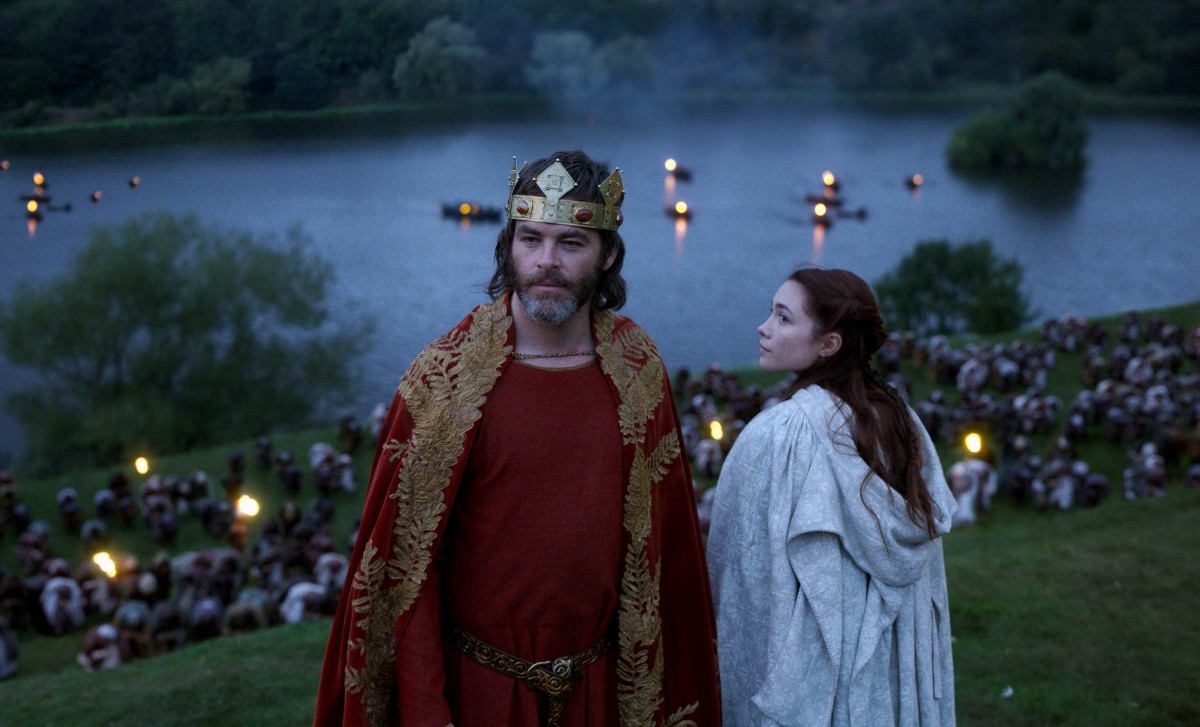
Outlaw King (2018)
Rating: C
Dir: David Mackenzie
Star: Chris Pine, Florence Pugh, Stephen Dillane, Billy Howle
On the one hand, this is another case of “kiltwashing”; you don’t get much more American than Captain Kirk (v2.0) himself. But the film gets credit for most other areas in this regard. Director McKenzie is Scottish, and still lives there after a brief flirtation with Hollywood. It was also filmed in Scottish locations; though as is sadly normal, Scotland appears to stop at Aviemore. There has been some shade thrown at this for playing fast and loose with historical authenticity. In particular, the Battle of Loudon Hill which forms the film’s climax, is radically different from the way it unfolded in reality. Bruce was also already married to Elizabeth (Pugh) well before he began his rebellion against the English king, Edward I (Dillane). It still does considerably better than Braveheart in this area. Then again, Highlander is probably more historically accurate than Braveheart. Not, to be honest, that I care. This is not a documentary.
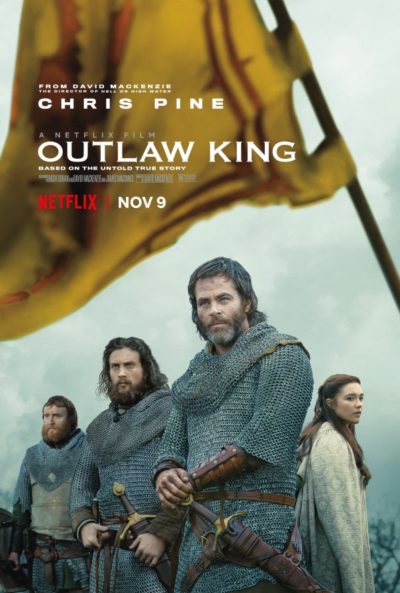 Anyway, it begins with Edward I having suppressed a Scottish revolt, and forcing their nobles to bend the knee. There’s an amazing, unbroken 9-minute opening shot which includes this, a swordfight between Bruce and the king’s son (Howle), and the enthusiastic application of an F-sized catapult against Stirling Castle. Sadly, it’s largely downhill from there, perhaps due to five writers including Mackenzie. The film seems to be pulling in an equal number of different directions, and only sporadically comes to life – usually when people are trying to kill each other. It follows Bruce as he plans a second rebellion after the death of William Wallace (whose limb makes a cameo). Robert gets his arse handed to him and retreats to the Western Isles to regroup. He and his allies return to wage guerilla battle against the English, leading up to the Loudon Hill battle. It ends in a lengthy set of captions covering the next 300 years.
Anyway, it begins with Edward I having suppressed a Scottish revolt, and forcing their nobles to bend the knee. There’s an amazing, unbroken 9-minute opening shot which includes this, a swordfight between Bruce and the king’s son (Howle), and the enthusiastic application of an F-sized catapult against Stirling Castle. Sadly, it’s largely downhill from there, perhaps due to five writers including Mackenzie. The film seems to be pulling in an equal number of different directions, and only sporadically comes to life – usually when people are trying to kill each other. It follows Bruce as he plans a second rebellion after the death of William Wallace (whose limb makes a cameo). Robert gets his arse handed to him and retreats to the Western Isles to regroup. He and his allies return to wage guerilla battle against the English, leading up to the Loudon Hill battle. It ends in a lengthy set of captions covering the next 300 years.
Sadly, the Bit With the Spider, which every schoolboy learned about Bruce, appears to have been left on the cutting-room floor. So much for your so-called “historical accuracy,” eh? It also never manages to engage the emotions with any consistency. Pine has a decent accent, but in terms of performance, resembles his arboreal namesake. But as with The Bruce, it feels as if liberating Scotland was more a job Bruce was given; even his rabble-rousing pre-battle speech is utterly forgettable. Any life here is typically found around the edges in some decent supporting performances. Pugh shows sparky courage in standing up to her English colleagues, and Aaron Taylor-Douglas (yes, Kick-Ass himself) is a lot of fun as the contractually obliged lunatic Celt warrior.
The 121-minute edit delivered to Netflix manages to feel both short and too long simultaneously, which is an interesting feat. There’s a sense of the surface just being scratched, in the nods to political and clan intrigue. Yet there are also any number of scenes which felt superfluous and/or over-long. Not among those, however, is the final battle. Those fond of horses should avert their eyes, CGI or not.
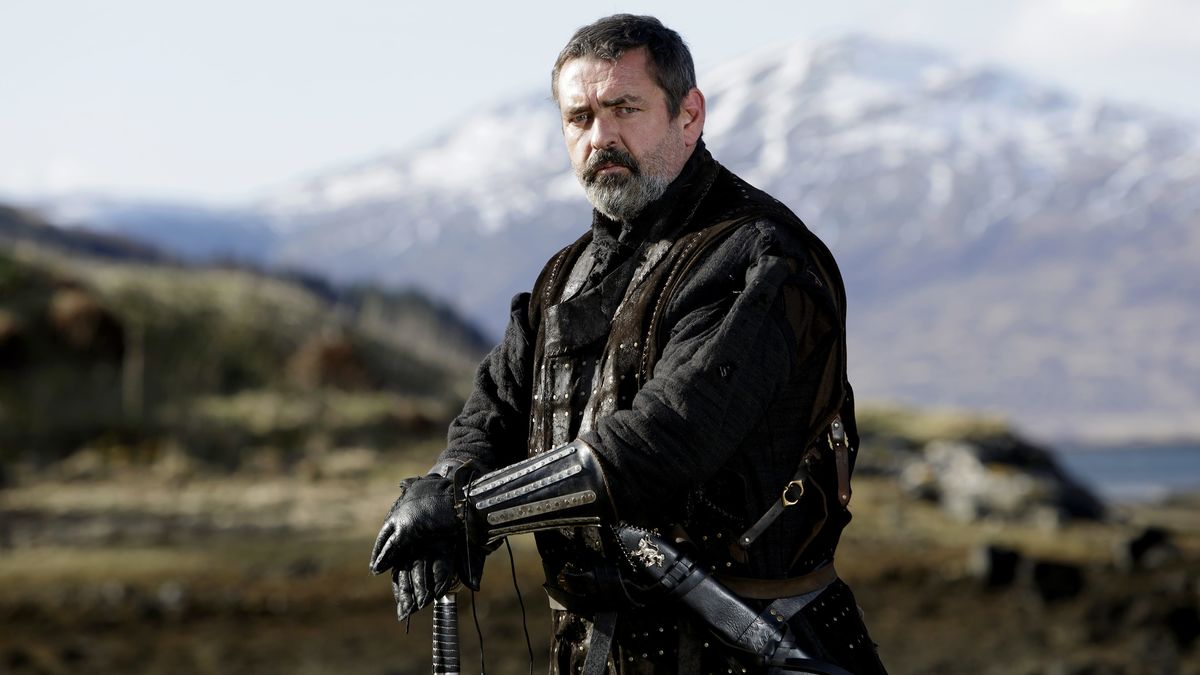
Robert the Bruce (2019)
Rating: B-
Dir: Richard Gray
Star: Angus Macfadyen, Anna Hutchison, Zach McGowan, Diarmaid Murtagh
Firstly, I have to say this one gave me nostalgic feelings for watching crappily subtitled Hong Kong movies in the nineties. For some reason, watching this on Hulu, we had the closed captions on… and whoever transcribed them was clearly not familiar with the Scottish accent. I’ve not seem more “[inaudible]”, for perfectly audible lines, and some of the transcriptions were spectacularly wrong-headed. For example, “Our faith is tied to yours” was subtitled as “Our faith has tired tears.” Perhaps most woefully, on discussing the price on the Bruce’s head, it was announced that anyone turning him in “shall receive the sum of 50 gold pieces.” The captions? “Shall we see the son of [inaudible] gone to pieces.”
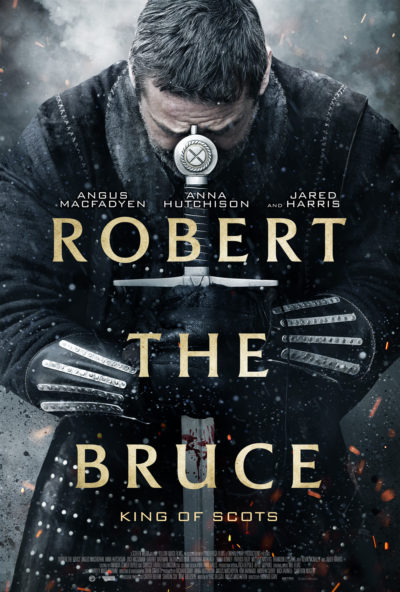 This begins with the face-off between Robert the Bruce and John Comyn at Greyfriars, over whether Scotland should continue to rebel against England. It turns out this is being told, as a story, by widowed crofter Morag (Hutchinson) to her children, some years later. Bruce has suffered multiple defeats, and it’s now just him and a few hardy supporters, with (as mentioned above), a bounty on him. What’s particularly notable here is the absence of the English, who hardly appear at all: this depicts a Scotland which is fractured down the middle. You’re either for Comyn or for Bruce: the question of which is often raised, and impacts relationships, even among Morag’s family. Her husband was killed fighting for Bruce, but his brother (McGowan) – a Comyn supporter – is now sniffing around the widow. So when a wounded Bruce turns up on her doorstep, after fending off an ambush, she’s faced with a troubling dilemma. Does she honour her own belief in Bruce, along with that of her late husband? Or cash in on the life-changing reward?
This begins with the face-off between Robert the Bruce and John Comyn at Greyfriars, over whether Scotland should continue to rebel against England. It turns out this is being told, as a story, by widowed crofter Morag (Hutchinson) to her children, some years later. Bruce has suffered multiple defeats, and it’s now just him and a few hardy supporters, with (as mentioned above), a bounty on him. What’s particularly notable here is the absence of the English, who hardly appear at all: this depicts a Scotland which is fractured down the middle. You’re either for Comyn or for Bruce: the question of which is often raised, and impacts relationships, even among Morag’s family. Her husband was killed fighting for Bruce, but his brother (McGowan) – a Comyn supporter – is now sniffing around the widow. So when a wounded Bruce turns up on her doorstep, after fending off an ambush, she’s faced with a troubling dilemma. Does she honour her own belief in Bruce, along with that of her late husband? Or cash in on the life-changing reward?
This is certainly a very human portrayal of Bruce, and better for it. He’s highly fallible, and very much tempted to give up. This even includes the legendary incident of him seeing a spider trying to spin its web, teaching him a lesson about perseverance. It’s almost certainly total bollocks, historically, but none the less effective for it. However, I do have to take points off for being mostly shot in… Montana. Was Scotland somehow unavailable? You can tell, since Scotland, while having its moments, just isn’t as spectacularly vertical [Highest point in Montana: Granite Peak at 12,799 feet, close to three times that of Scotland’s Ben Nevis] It is, clearly, also on a smaller scale, with the battles being mere skirmishes, involving just a few on either side.
Arguably, Bruce is not even the lead here; you could make a case it’s Morag’s story. If, however, you are fine with that, not looking for something epic, and are good with more personal drama, occasionally interrupted by sword-swinging, this may well hit the mark. This was obviously a labour of love for McFadyen, who wrote the script over a decade earlier. He reprises his character from Braveheart to good effect, and is considerably more sympathetic here. While he’s a couple decades older than Bruce actually was, this just adds a not inappropriate air of world-weariness.
